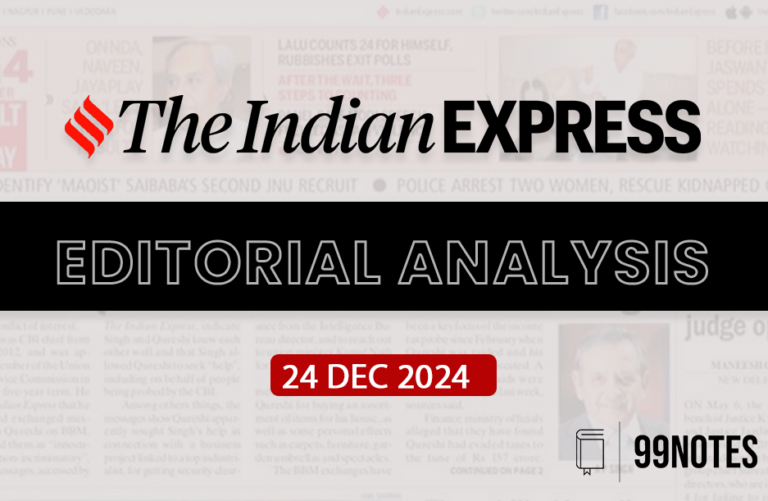30 December 2024 : The Hindu Editorial Analysis
1. Incidents on loop, but it’s escape for regulator, airlines
(Source – The Hindu, International Edition – Page No. – 8)
| Topic: GS3 – Disaster Management |
| Context |
|
Aviation Safety in India: Challenges and the Way Forward
Historical Incidents Highlighting Safety Gaps
- Runway Confusion Cases:
- 1993: Jet Airways landed at an airbase instead of Coimbatore’s civil airport.
- 2018: An Air India Airbus A320 landed on a wrong (under-construction) runway in the Maldives.
- Runway Overruns:
- 2010: Mangaluru crash resulted in 158 fatalities.
- 2020: Kozhikode crash led to 21 deaths, linked to crew fatigue and operational pressure.
Contributing Factors to Safety Issues
- Regulatory Oversight:
- The Directorate General of Civil Aviation (DGCA) is often reactive rather than proactive, blaming pilots while systemic failures persist.
- Non-compliance with International Civil Aviation Organization (ICAO) standards on aerodrome infrastructure.
- Training and Standards:
- Deficient pilot training and lack of emphasis on runway markings.
- Recurring incidents point to inadequate safety audits and oversight by the DGCA’s Flight Standards Directorate.
- Crew Fatigue and Pressure:
- India’s flight and duty time regulations are among the weakest globally.
- Operational pressures like “on-time performance” (OTP) targets compromise decision-making in critical situations.
Lessons from International Best Practices
- Singapore Airlines, after a 2000 crash due to runway confusion, implemented immediate corrective actions, ensuring no recurrence of similar incidents.
- India needs to adopt such proactive measures to enhance safety and accountability.
Recommendations for Improvement
- Strengthening Oversight: DGCA must enhance safety audits and enforce strict compliance with ICAO standards.
- Improving Training: Airlines should focus on comprehensive training for pilots, emphasizing runway markings and stabilized approach criteria.
- Addressing Crew Fatigue: Regulations on flight and duty time limitations must prioritize crew rest and safety over operational efficiency.
- Promoting Accountability: Airlines and regulatory bodies must share responsibility for incidents, ensuring systemic changes to prevent recurrence.
Conclusion
- Aviation safety in India requires a shift from reactive measures to proactive strategies.
- Enhanced oversight, rigorous training, and prioritizing crew well-being are essential to fostering a safer aviation environment.
| Practice Question: What are the systemic shortcomings in Indian aviation safety, and how can they be addressed? (150 Words /10 marks) |
2. One Nation One Election and representative democracy
(Source – The Hindu, International Edition – Page No. – 8)
| Topic: GS2 – Indian Polity |
| Context |
|
| Key Features of The Constitution (129th Amendment) Bill, 2024: |
|
Benefits of ONOE
- Administrative efficiency and reduced election fatigue are cited as primary benefits.
- Simultaneous elections aim to streamline governance and reduce the disruptions caused by frequent elections.
Challenges to Representative Democracy
- Defining Representative Democracy: Representative democracy relies on elected representatives making decisions on behalf of citizens, balancing majority rule with minority rights, and ensuring stable governance.
- The system depends on periodic elections, informed participation, and institutional checks and balances, which face growing challenges globally.
Findings from Pew Research Center Study (2024)
- Across 24 nations, including India, citizens expressed disillusionment with representative democracy.
- Many citizens explored alternatives like direct democracy, expert rule, or authoritarian systems.
- Support for military rule ranged from 15% to 17% in some nations, reflecting frustration with inefficiencies and unfulfilled promises.
Concerns with the ONOE Process
- Inadequate Public Consultation: A 10-day period for public feedback (January 5-15, 2024) was insufficient.
- Lack of Explanatory Notes: The absence of background materials limited citizens’ understanding.
- Framing of Questions: The public was asked for simple ‘yes/no’ responses, appearing to pre-determine the outcome.
Implications of ONOE on Representative Democracy
- Centralization vs Federalism: Synchronizing elections risks centralizing power, overshadowing state-specific issues.
- Inclusivity and Participation: Rushed reforms and curtailed consultations weaken democratic inclusivity.
- Electoral Accountability: Simultaneous elections might reduce frequent evaluations of governments, diluting accountability.
Conclusion
- India’s democratic fabric thrives on inclusivity, participation, and accountability.
- While ONOE aims for efficiency, it must adhere to the principles of representative democracy to maintain trust and reflect diverse perspectives.
| PYQ: ‘Simultaneous election to the Lok Sabha and the State Assemblies will limit the amount of time and money spent in electioneering but it will reduce the government’s accountability to the people’ Discuss. (150 words/10m) (UPSC CSE (M) GS-2 2017) |
| Practice Question: Evaluate the impact of simultaneous elections on electoral accountability, federalism, and inclusivity within India’s representative democratic framework. (250 Words /15 marks) |
For more such UPSC-related The Hindu Editorial analysis, Check Out: –28 December 2024: The Hindu Editorial Analysis





